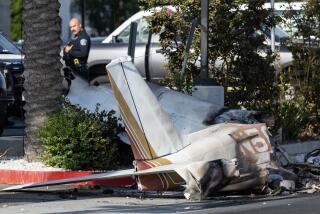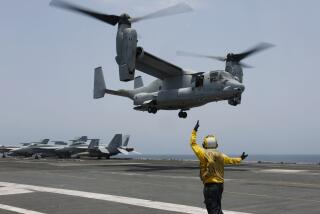Harrier Crash Tied to Repair Debris
ATLANTA â An AV-8B Harrier attack jet that crashed into North Carolinaâs Pamlico River last year may have been felled by a tiny piece of debris left behind after mechanics repaired a fuel leak, a Marine Corps investigation has determined.
The pilot ejected safely, but the $28.2-million plane was destroyed.
It was one of three major accidents in 2002 involving the crash-prone Harrier, which can take off and land vertically. Marine officials had said they thought they had remedied the planeâs myriad problems just before the first of the crashes.
Another of the so-called jump jets crashed this year while attempting to land on a ship in the Persian Gulf during the war against Iraq. The pilot survived the accident, as did those involved in the other two crashes last year. Investigations into the causes are pending.
The Harrier has the worst major-accident rate of any active plane in the U.S. military, and it was the focus of an investigative series in the Los Angeles Times in December.
Over the last 32 years, it has been dogged by mechanical breakdowns, maintenance mistakes and pilot errors -- in part because the jet was grounded so often that pilots could not get adequate flight time. Forty-five Marines have perished in 144 major noncombat accidents that have wiped out a third of the Harrier fleet.
A Marine Corps investigation found evidence that a maintenance oversight may have caused the Pamlico River crash. It also noted that, in the month leading up to the crash, the pilot did not log enough hours to meet the minimum goal for proficiency -- although his actions did not appear to be a factor in the accident.
The report of the investigation into the July 22 crash, which was obtained by The Times through the Freedom of Information Act, did not assign blame. But it concluded that the engine failed because of foreign object damage and that âthe foreign object appears to have been a rivet stemâ that nicked a compressor blade, causing the engine to stall and then melting portions of the turbine section. The pilot, Capt. James W. Troy, steered the plane away from a mine and then ejected at about 2,000 feet. He was rescued by civilian boaters and suffered minor injuries.
Less than a month before the crash, maintenance workers at the Naval Aviation Depot at the Marine Corps Air Station in Cherry Point, N.C., had conducted a series of repairs that required them to pull back the Harrierâs skin not far from one of the massive intakes that help produce the planeâs thrust. A mechanic replaced the skin using hundreds of rivets fired by a gun, and some of the rivets produced stems as waste.
The Harrier is known to be susceptible to foreign object damage because debris is easily blown into the intakes. The Marines have detailed procedures for preventing such damage and for inspecting planes before flight. In this case, the mechanic doing the repairs told investigators he had sealed off various openings, caught the stems in his hand and conducted a thorough inspection. Colleagues described him as meticulous.
Although the investigation reached no conclusion about how a rivet stem might have entered the planeâs engine, it recommended that Harrier squadrons formalize written procedures for accounting for rivets during all repairs.
Troy told investigators that he was flying at about 10,000 feet when he heard a loud noise that he compared to âa grinding and ripping of metal.â As he radioed âMayday, Maydayâ to flight controllers, Troy noticed that the planeâs engine temperature was rising quickly and that the plane was losing power. Troy was commended by commanding officers for steering the plane away from populated areas and toward the river before ejecting. The investigators found, however, that he had logged only 7.8 hours of flight time in the previous 30 days and only 16.8 hours in the previous 60 days, far less than the 15 to 20 hours a month recommended by the Marines.
After publication of The Timesâ articles, and under pressure from Congress, Marine Corps aviation officials vowed to increase the amount of flying time for Harrier pilots.
*
Sack reported from Atlanta and Miller from Washington, D.C.
More to Read
Sign up for Essential California
The most important California stories and recommendations in your inbox every morning.
You may occasionally receive promotional content from the Los Angeles Times.










